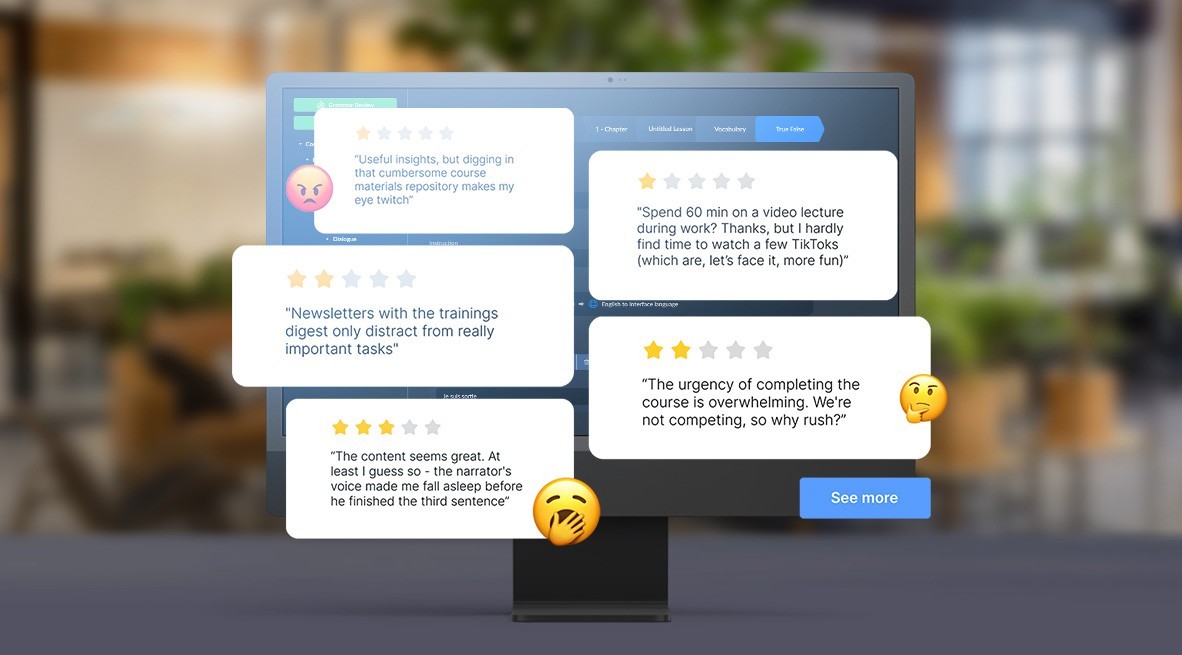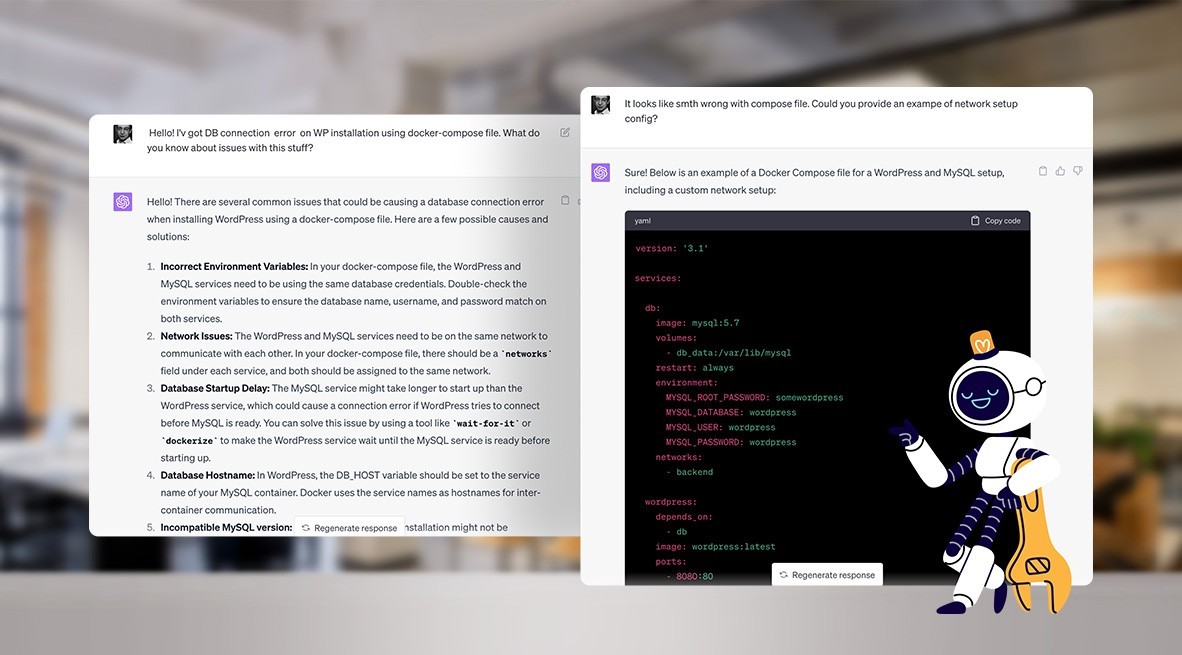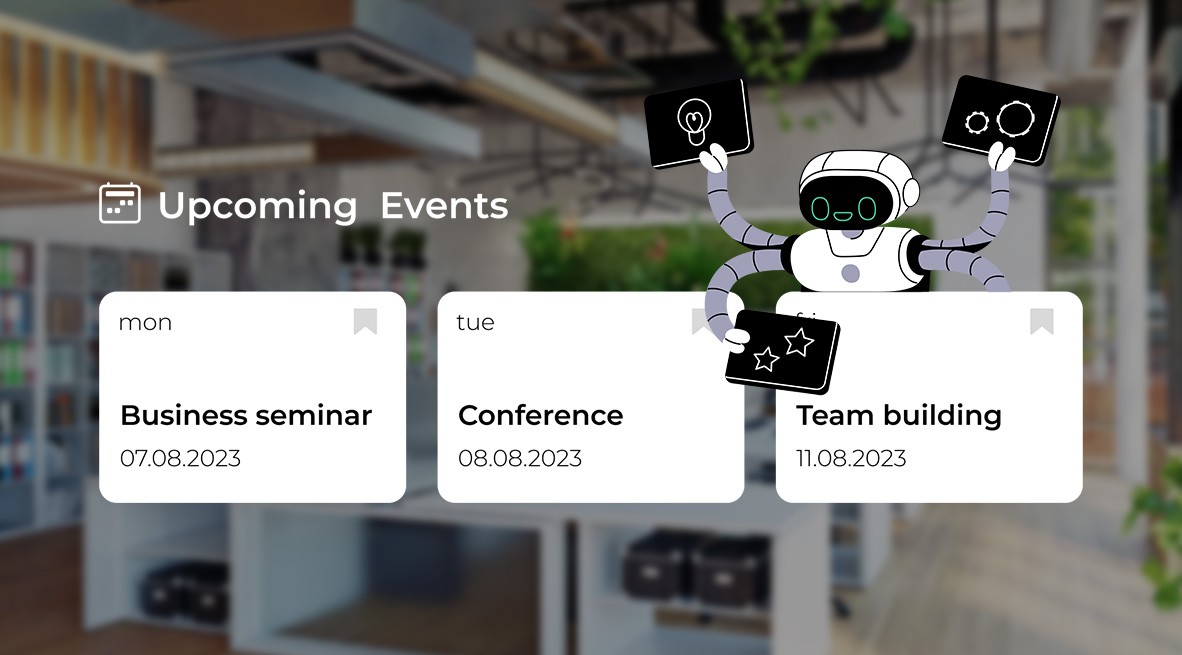Great threat and even greater opportunity
It feels like only recently has the pandemic helped businesses discover new audiences that moved online, when 2023 brought a new concern from where less expected: AI, in the face of ChatGPT and others of its ilk, has started muddying the waters and is now actively taking away droves of paid services’ clients.
In one EdTech domain alone, numerous mid-sized companies experience a notable decrease (of at least 5%) in their share price, as well as a drop in subscribers, in profits, and in the morale of the companies’ employees.
Have you imagined that bleak picture? Great, for what follows is going to brighten things up.
While that is one camp of businesses affected by AI technologies, that keep on ignoring it, there’s another one. It’s made up of companies that are adapting to this trend and pushing the boundaries of their products with ChatGPT-powered features and tools.
And judging by the current status quo, the abyss between these two camps will only grow bigger.
Oxagile, as you’ve probably guessed, joined the latter one. Our team is actively using ChatGPT for business, incorporating AI into our clients’ solutions and constantly monitoring its updates to recognize where and how to most effectively leverage its new capabilities.
So, let’s jump to what you care about the most: practical demonstration of implementing the ChatGPT natural language processing tool in real products, workflows, and projects.
Get inspired: Real-life business use cases for ChatGPT
Since our clients recognize the significance of this AI chatbot, we have already expanded our portfolio with many unique ChatGPT use cases for business, including taking over customer support, content review and… Well, let’s take these project cases one by one.
1. Smart feedback provision within an eLearning platform
Project overview
A key component of the language learning app that we were creating included a peer-to-peer interactive forum where students had a chance to complete tasks and make their answers publicly available for other students to check and provide feedback on everything that was wrong, from grammar to word choice.
Despite its simplicity, this community feature played a crucial role in facilitating user communication, forging new friendships, and maintaining the students’ enthusiasm to learn.
Challenge encountered
Some exercises shared by users were not getting a timely response, which undoubtedly didn’t contribute to the supportive environment and had a negative impact on the overall motivation of users.
ChatGPT-driven solution
To ensure prompt feedback acknowledging users’ efforts, we came up with a bot based on the OpenAI model. So now, if an exercise does not receive a response from another user within 5 hours, it serves as a trigger for the bot to leave constructive and helpful comments and corrections.

2. Educational content review and optimization
Project overview
A learning platform offering general programming education, which creates almost all explanatory materials in manual mode, has been placing significant emphasis on tests and quizzes after each lesson to reinforce knowledge and encourage active learning.
Challenge encountered
There was a significant churn rate following the completion of 3–5 lessons. An analysis proved that it was caused mainly by the fact that students were frustrated by the large number of tricky questions in tests.
While questions containing a catch could be effective in certain contexts, such as driver’s tests, they turned out to be a poor approach when the goal was to educate and inspire students to learn more rather than to cause confusion.
ChatGPT-driven solution
After obtaining from the current teachers some samples of questions that could potentially push students towards making mistakes, we trained the model to categorize all quiz questions on the platform into “suitable” and those that might “make students feel overwhelmed or bewildered.”
3. LMS content creation
Project overview
A learning management system (LMS) used by one major technological company was constantly expanding its content, carrying out ongoing skills testing for employees, and, following the principle of continuous education, enriching the existing courses with fresh materials.
Challenge encountered
The release of new courses was often delayed and slowed down as educators prepared exercises in large quantities, unable to keep up with the needs of the students.
At the same time, everything was done manually, as there were concerns that automating the process could be detrimental and result in illogical, low-quality exercises.
ChatGPT-driven solution
For certain types of courses included in this LMS, especially language learning ones, integrating ChatGPT has proven to be an excellent solution saving time and allowing teachers to focus on delivering the lessons rather than compiling similar exercises.
This way, for instance, ChatGPT now generates human-like, high-quality personalized questions for students where it is necessary to reinforce a specific topic or rule.
4. Retail chain customer feedback classification and analysis
Project overview
To spot the recurring patterns and tendencies concerning different aspects of the business, as well as to identify areas to address and enhance the customer experience, the owners of a retail chain were committed to daily examining all customer reviews and feedback.
Challenge encountered
While manually looking through the reviews was wasting a lot of time and, most importantly, human resources, we implemented sentiment analysis, using the Amazon Web Services tool, to understand the semantics of a review (whether it was “positive”, “negative” or “neutral”).
But the challenge persisted, as there were loads of aspects covered and evaluated. Besides, a single review could contain positive feedback about the product quality, and negative about customer service, which made it hard for the tool to analyze the details.
ChatGPT-driven solution
To separate reviews by subjects and differentiate information in one single review, for example, about the satisfaction with the products offered, staff friendliness, and a store’s atmosphere, we implemented a meticulous ChatGPT prompt that now processes the reviews together with the AWS tool and provides structured data ready for analysis and data-driven insights.

5. Handling consumer reviews
Project overview
A small part of the services provided by a brand reputation monitoring company is tracking consumer reviews, actively engaging with customers, and addressing objections to boost their clients’ ratings.
Challenge encountered
Many clients who availed themselves of the company’s services, which also encompass tasks such as managing business accounts, crafting posts, and elaborating business strategies, expressed a desire for some cost reductions without compromising the quality of service. In response to this, the company considered a few business ideas and identified an area where they could help clients save money: automating the process of answering their comments and reviews.
ChatGPT-driven solution
We integrated the ChatGPT model with the platform via an API, allowing clients to input text reviews written by their customers and request well-crafted responses. While there is still a manual aspect involved in this process, such as adding the reviews and manually refining responses if desired, overall, the process is significantly accelerated. Furthermore, ChatGPT is trained to provide high-quality and personalized responses, enhancing overall customer satisfaction without much brainstorming from the reviewer.
See if ChatGPT is right for your needs
If you doubt whether ChatGPT is good for handling your tasks and solving your challenges, we are delighted to show you how to get the most out of this AI tool, rather than just using it to follow the fashion.
Top 10 ChatGPT use cases to streamline business task completion
ChatGPT is also slowly but surely reshaping the way Oxagile staff perform routine as well as non-trivial tasks. Here are the most popular examples of how we, as well as our clients, take advantage of OpenAI capabilities to facilitate business operations:
1. Fixing code issues
It’s hardly a revelation that ChatGPT can be used as a more convenient version of Google, that won’t make you dig into Stack Overflow or similar forums for a solution lost somewhere in the endless pages. When interacting with ChatGPT, spotting a mistake in a piece of code will boil down to copy-pasting it and asking the AI chatbot for a diagnosis.
And though sometimes the information that ChatGPT has been trained on may not be enough to notice a mistake, our experience shows that in many cases it still serves as a reliable alternative to static code analyzers.

2. Providing code examples
Let’s take the liberty of noting that a considerable part of programming consists of compiling ready-made code parts that were written by someone else and adjusting the result to your specific usage. And according to our developer’s feedback, ChatGPT perfectly copes with this task, saving time on searching for code snippets on other sites.
However, it is to be understood that asking ChatGPT to solve problems that no one has solved yet is a dead end. At least for now.
3. Technical-to-human translation
When there are technical specifications of the project that need to be presented to the client, so that he does not get bogged down in specific jargon, or persuasively describe the need for migrating data to microservices to the manager, who probably sees this combination of words for the second time in his life, ChatGPT is great to concisely reformulate all technical data into an exciting story.
4. Creating bite-sized courses
In case there’s a project coming up that requires brushing up on tools used some time ago or figuring out what new features have appeared in familiar programs, we take advantage of the brilliant ChatGPT ability to create step-by-step learning plans and programs specifying resources and materials that are worth checking out depending on specific goals.
5. Turbo speeding automation
ChatGPT allows our QA engineers to speed the test lifecycle and reduce the QA workload by 5–6 times by generating unit tests based on the context and the desired outcome. It quite clearly analyzes given requirements and provides good results, creating competent tests that help to avoid the accumulation of errors and free up time for our QA team members to perform a range of other crucial tasks.
6. Revealing undercover ideas
ChatGPT is also a nice source of inspiration for our project managers at a stage when a lot of functionality has already been implemented in the project, but we still want to enhance it. In this case, we provide ChatGPT with the context of what we do and what our vision is, and ask it to brainstorm on fresh features that we later transform into valuable upgrades.
7. Suggesting events for a company to attend
Oxagile event managers keep filling our calendars with the conferences suggested by ChatGPT, as it proved to be quite useful in determining the ones that were seemingly unrelated to our field of expertise, but still had potential for our company to make connections and develop new business ideas.
Of course, it is not a one-stop solution for all the work, at least because its internal knowledge about the latest events may be quite limited, but, nonetheless, it is worth paying attention to.

8. Summarizing lengthy texts
Life is too short to read the whole user agreement. Basically, just like any other lengthy text, ChatGPT agrees with this statement and easily provides brief summaries of specialized articles, highlighting what our team members ask it to single out or answering questions about the content of the document provided. This is probably one of those ChatGPT use cases that we enjoy across almost all departments.
9. Speeding up keyword research
Despite the fact that ChatGPT is quite a creative companion, entrusting it to craft meticulously optimized SEO articles may be quite a risky thing to do. However, seeking its assistance to write a list of keywords relevant to your topic or even analyze your competitors to understand the competitive landscape is a reasonably achievable task. The main thing is to clearly outline the task you have in mind, and ChatGPT will come up with a comprehensive list.
10. Generating interview questions
Our HR managers proved that ChatGPT can be turned into a tool that helps develop in-depth interview questions for an expert in practically any field. By providing details, such as job requirements and the essential hard skills expected from an ideal candidate, ChatGPT compiles a set of open-ended questions that may include various aspects, like problem-solving scenarios, which aim to evaluate the knowledge and capabilities of individuals possessing the specified expertise and experience.
Conclusion
While this is certainly only a small part of all the fun and enhancements that AIs can strengthen numerous products and processes with, we’d also like to emphasize, drawing from our practical experience, that making serious product upgrades with solutions based on AI tools makes sense only after carefully determining that it is relevant and cost-effective in your particular case.
However, while rushing to develop features just for the sake of having them is not the best goal to pursue, it is definitely worth considering all the opportunities and new value that AI can bring to your business.
If you’re eager to discover the potential profitability of embracing AI-powered innovations, or if you simply seek inspiration for fresh business ideas that can elevate your product or service, Oxagile is always here to lend you a helping hand and share its expertise to incorporate any AI advancements in the most beneficial and justified manner.
FAQ
While ChatGPT may seem ready to answer any question, ranging from philosophical inquiries to practical programming tricks, it itself often sparks quite intriguing questions from those who reach out to us seeking its implementation in their businesses. Here are the answers to some of them.
What is the best use case for ChatGPT?
It’s hard to choose just one example that stands out among the variety of great ChatGPT use cases for business. However, from our point of view, providing natural language replies in response to users input is probably one of the most valuable ChatGPT functions that saves the company’s money and resources, while also increasing user loyalty and trust.
Can you totally entrust ChatGPT with content creation?
As the algorithm of this natural language processing tool was trained on a very large data set, it not only understands how meaningful human speech works to be able to conduct conversations, but is also perfectly suited to create useful and informative materials. At the same time, it often uses patterns and templates, making the content it produces quite recognizable and repetitive. And there is a chance that some of the massive amount of data on the internet that ChatGPT has been trained on has been biased or incorrect. Therefore, it is often crucial to fact-check when using this AI tool.
However, it should be noted that correctly drafted prompts, specifying important conditions and telling ChatGPT how to act, minimize these kinds of issues.
























